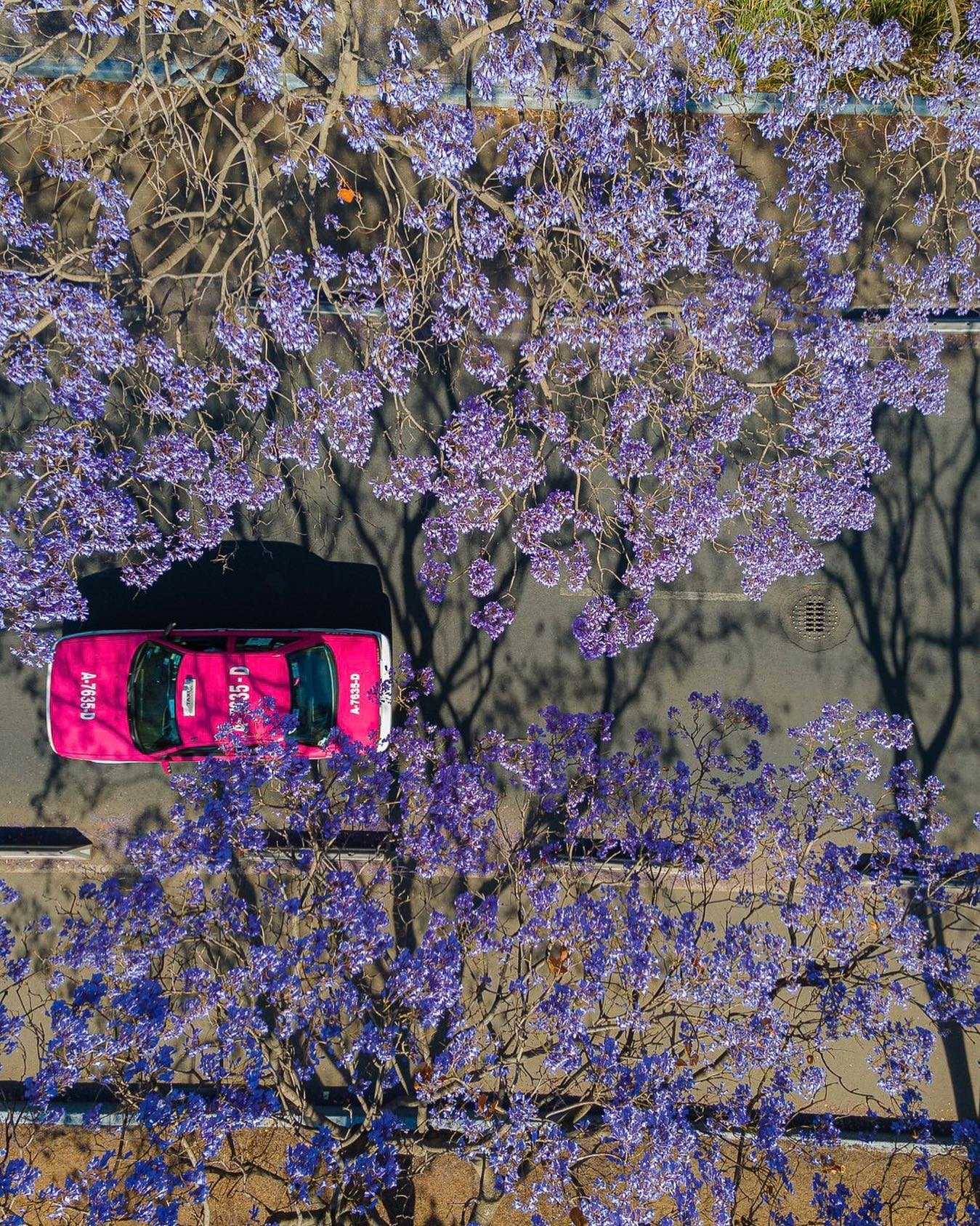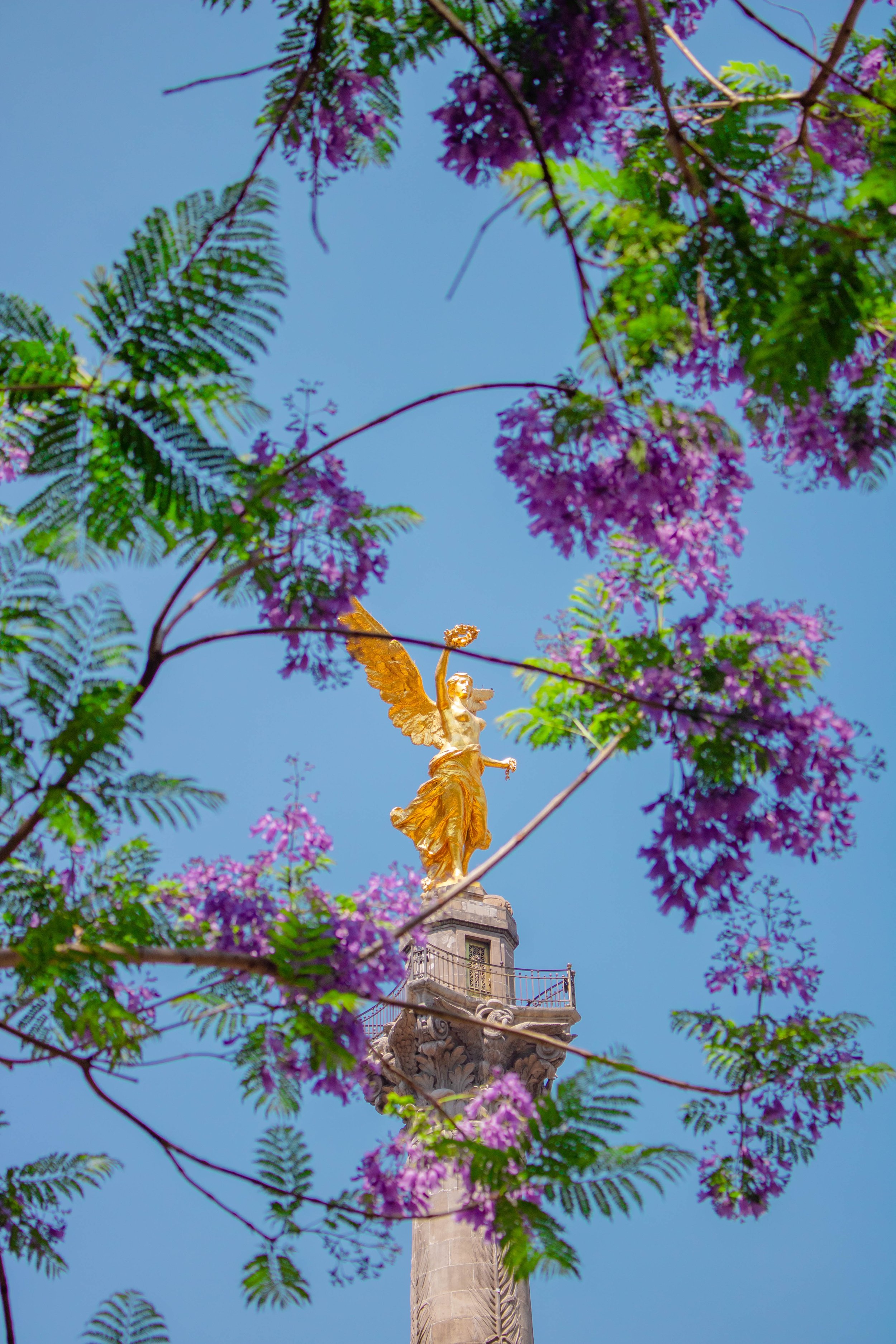Follow The Jacarandas & Discover Mexico City
E
very spring in Mexico City, the parks and boulevards have their own way of announcing that the dry and smoggy winter has come to an end. It’s in late February that the first few pops of purple begin to spread across the city—you might notice it first crossing the street, or at a random corner, when you see a light carpeting of petals in a violet hue. In March, the purple takes over, as some of the city’s most iconic sites from the Chapultepec Forest and Reforma boulevard to the gardens of the National Autonomous University of Mexico (UNAM) one by one are washed in color.
This annual occasion is due to the jacaranda trees, as iconic to this city as the cherry blossoms to Washington, D.C., and the reason that spring is the best time to visit Mexico City. And like the cherry blossoms, though they seem integral to the city’s landscape, the jacarandas are also nonnative to the region.
Photography @laicy.falstad & @casa_gilardi
One of the best places to see the influence of the jacaranda tree is at Casa Gilardi. This residential home was one of the final works by Pritzker-prize winning architect Luis Barragán, who designed the entire structure around the jacaranda that now sits in the central courtyard. Barragán saw “natural elements—in this case green elements—[as] a human need. It’s something that we need to improve our lives,” explains Eduardo Luque, a member of the family who owns Casa Gilardi home and who grew up in the house, in a phone interview with The Suitest.
The story of how the jacarandas arrived shows the legacy of Mexico as a melting pot of cultures and traditions. At the turn of the 20th century, the city’s elites were interested in mimicking international designs in their palatial haciendas. One of these city leaders, Jesús Landero, invited a Japanese gardener and landscape architect named Tatsugoro Matsumoto to come design a Japanese-style garden at his home.
Matsumoto, at the time, was working in Peru at the behest of the Japanese government. He came to Mexico in 1896, carrying seeds in his luggage—those of bougainvillea and, of course, jacaranda.
Supposedly, Matsumoto had fallen in love with the jacaranda—native to Brazil—because its annual blooming reminded him of the cherry blossoms of his home. Though the color was different, purple instead of pink, the yearly cycle that made cities into festivals of color convinced him that the jacaranda was the cherry blossom of the Americas.
In Mexico, his work caught the eye of the president at the time, Porfirio Diaz, an autocrat who would be overthrown during the Mexican Revolution in 1911. Diaz had the ambition to make Mexico City rival the great European metropolises: he modeled Reforma after the Champs-Élysées and ended up hiring Matsumoto to design the gardens around the Chapultepec Castle.
Matsumoto, against the odds, stayed in Mexico and remained in favor even through the tumultuous era of the Revolution.
Decades later, in the early 1930s, President Pascual Ortiz Rubio commissioned him to plant the iconic jacarandas along Reforma and through the historic center of the city.
In Mexico City, due to the high altitude and mild climate, the jacarandas produce an even greater bloom than in their native Brazil. They have since become such an iconic part of the city from February to May that many locals believe they are native to the region.
Today, some of the best places to witness the blooming jacaranda run the length of the city. In the Historic Center, the square in front of the Museo de Bellas Artes and the Alameda (the park to its west) are home to several flowering trees. Then, wind down to Reforma, which is flanked by jacaranda trees all the way to the Bosque de Chapultepec.
From there, the Castillo de Chapultepec provides a commanding view of the entire forest, speckled with the purple blooms. The Bosque sits next to the stylish neighborhoods of Condesa and San Miguel Chapultepec, where you’ll find Casa Gilardi.
Luque says the tree at the center of the house is between eighty and ninety years old, according to his research. “The tree is the essence [of the structure],” he says. “Of course, the house is a masterpiece, it’s beautiful. But if you remove this tree it will feel completely different.” The tree’s shadows play off the colored walls of the building, and Barragán chose the primary purple paint color because it matches the color of the jacaranda’s flowers.
Luque has seen the city embrace the trees to an even greater extent over the course of his life. “When I was a kid, we had [jacarandas], but it’s a tree that needs a lot of time [to reach its full growth].…Now I notice that people start enjoying spring—of course because of the weather—but [also] because of the trees.”
The jacarandas also provide a reason to venture beyond the typical tourist zones. Travel south from Condesa and take a ride—using the city’s bike-share service and ample designated lanes—through the neighborhoods of Narvarte and Del Valle. There, you will find jacarandas blooming on the streets of Tajín, Nicolás San Juan, Concepción Béistegui, and Miguel Laurent in the direction of the cobblestoned, artsy neighborhoods of Coyoacán and San Ángel. Further south, jacarandas also bring color to the UNAM campus and the Pedregal, the south part of the city that is lined with volcanic rock and was another favorite locale of the architect Barragán.
During the pandemic, tourism to Mexico City has not suffered as much as other international destinations due to its loose restrictions and proximity to the United States. There has also been an influx of digital nomads looking to take advantage of new remote work policies.
But few tourists know that the iconic sight of purple flowers carpeting the streets and announcing the arrival of spring have a Japanese gardener and the Brazilian forest to thank. This spring, celebrate a return to travel with an ephemeral experience that defines a city.






